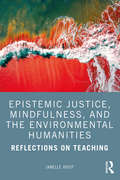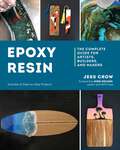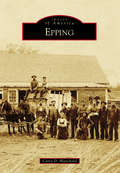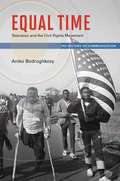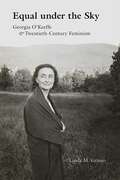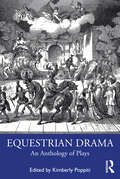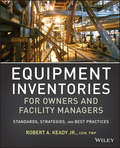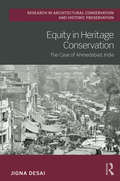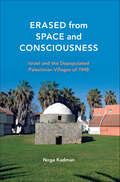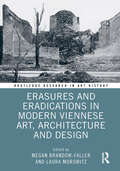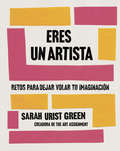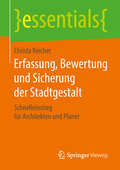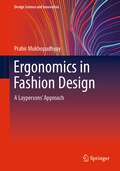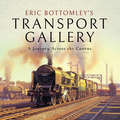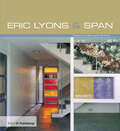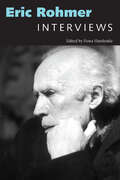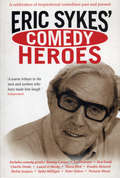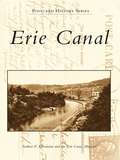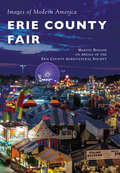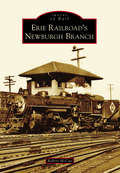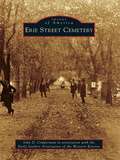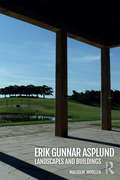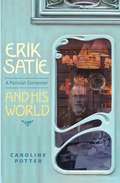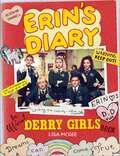- Table View
- List View
Epigram, Art, and Devotion in Later Byzantium
by Ivan DrpićThis book explores the nexus of art, personal piety, and self-representation in the last centuries of Byzantium. Spanning the period from around 1100 to around 1450, it focuses upon the evidence of verse inscriptions, or epigrams, on works of art. Epigrammatic poetry, Professor Drpić argues, constitutes a critical - if largely neglected - source for reconstructing aesthetic and socio-cultural discourses that informed the making, use, and perception of art in the Byzantine world. Bringing together art-historical and literary modes of analysis, the book examines epigrams and other related texts alongside an array of objects, including icons, reliquaries, ecclesiastical textiles, mosaics, and entire church buildings. By attending to such diverse topics as devotional self-fashioning, the aesthetics of adornment, sacred giving, and the erotics of the icon, this study offers a penetrating and highly original account of Byzantine art and its place in Byzantine society and religious life.
Epistemic Justice, Mindfulness, and the Environmental Humanities: Reflections on Teaching
by Janelle AdsitEpistemic Justice, Mindfulness, and the Environmental Humanities explores how contemplative pedagogies and mindfulness can be used in the classroom to address epistemic and environmental injustice. In recent years, there has been a groundswell of interest in contemplative pedagogies in higher education, with increasing attention from the environmental sciences, environmental humanities, and sustainability studies. Teachers and writers have demonstrated how mindfulness practices can be a key to anti-oppression and anti-racist efforts, both in and out of the classroom. Not all forms of contemplative pedagogy are suited for this anti-colonial and anti-oppressive resistance, however. Simply adopting mindfulness practices in the classroom is not enough to dislodge and dismantle white supremacy in higher education. Epistemic Justice, Mindfulness, and the Environmental Humanities advocates for mindfulness practices that affirm multiple epistemologies and cultural traditions. Written for educators in the environmental humanities and other related disciplines, the chapters interrogate the western uptake of mindfulness practices and suggest anti-colonial and anti-oppressive methods for bringing mindfulness into the classroom. The chapters also discuss what mindfulness practices have to offer to the pursuit of a culturally relevant pedagogy. This highly applied and practical text will be an insightful read for educators in the environmental humanities and across the liberal arts disciplines.
Epoxy Resin: The Complete Guide For Artists, Builders, And Makers
by Jess CrowCreate your own stunning objects, from easy projects to statement pieces, with the magic of epoxy resin. This groundbreaking maker’s manual masterfully guides you through the entire process, from proper planning to finished work. Learn how to prepare surfaces, which epoxy to use, and the right temperatures for your workspace and materials. Determine how much time you need for a project and how to support weight effectively. Understand how to mix and add colors and how to prepare and remove molds. Figure out how to achieve textures and tackle problems such as bubbles, drips, and dust. Explore color schemes, customizations, and ways to add impact and depth, including embedding objects, incorporating other media, and finishing techniques. Packed with tips, this must-have book features step-by-step instructions and photos for 12 projects—from bookmarks and coasters to countertops and dining tables—that anyone can create. The epoxibilities are endless.
Epping (Images of America)
by Corey BlanchardWith its lush forests, fertile land, and abundant waterways, Epping began attracting European settlers as early as 1710 before incorporating as an independent town in 1741. The town became home to successful farms, lumber operations, and mills built along the Lamprey River. Clay that lay beneath the fertile soil emerged as an important resource when commercial brickyards began popping up all over town in 1822. Epping became a crossroads for multiple rail lines, which spurred economic development and population booms. In 1862, undeveloped land became home to the Methodist campground Camp Hedding. Factories, especially those specializing in shoes, were established in the area as well. Epping's industrial concerns lasted until the late 20th century, when it grew as a retail center at the junction of Routes 101 and 125. Epping has been home to prominent residents, including a Revolutionary War general, three New Hampshire governors, a world heavyweight boxing champion, the first person to circumnavigate the world on a motorcycle, and a female collegiate basketball great.
Equal Time: Television and the Civil Rights Movement
by Aniko BodroghkozyEqual Time: Television and the Civil Rights Movement explores the crucial role of network television in reconfiguring new attitudes in race relations during the civil rights movement. Due to widespread coverage, the civil rights revolution quickly became the United States' first televised major domestic news story. This important medium unmistakably influenced the ongoing movement for African American empowerment, desegregation, and equality. Aniko Bodroghkozy brings to the foreground network news treatment of now-famous civil rights events including the 1965 Selma voting rights campaign, integration riots at the University of Mississippi, and the March on Washington, including Martin Luther King's "I Have a Dream" speech. She also examines the most high-profile and controversial television series of the era to feature African American actors--East Side/West Side, Julia, and Good Times--to reveal how entertainment programmers sought to represent a rapidly shifting consensus on what "blackness" and "whiteness" meant and how they now fit together.
Equal under the Sky: Georgia O'Keeffe and Twentieth-Century Feminism
by Linda M. GrassoEqual under the Sky is the first historical study of Georgia O&’Keeffe&’s complex involvement with, and influence on, US feminism from the 1910s to the 1970s. Utilizing understudied sources such as fan letters, archives of women&’s organizations, transcripts of women&’s radio shows, and programs from women&’s colleges, Linda M. Grasso shows how and why feminism and O&’Keeffe are inextricably connected in popular culture and scholarship. The women&’s movements that impacted the creation and reception of O&’Keeffe&’s art, Grasso argues, explain why she is a national icon who is valued for more than her artistic practice.
Equestrian Drama: An Anthology of Plays
by Kimberly PoppitiEquestrian Drama: An Anthology of Plays is a collection of four representative equestrian dramas. It includes four annotated plays: Timour the Tartar by Matthew G. Lewis, The Battle of Waterloo by J. H. Amherst, Mazeppa by Henry M. Milner, and The Whip by Henry Hamilton and Cecil Raleigh. An introduction precedes the collection, providing the information necessary to understand and contextualize the genre and the plays as both written and performance texts, and within the time period of their original productions, as well as within the larger histories of theatre and equestrian entertainments. Additional related plays are identified, excerpted, and explored, providing readers with a wide range of examples to better understand the development and significance of this unique form of popular theatre. Also identified and explored are significant contributions made to stage technology and design by the patented stage machinery designed for the production of the mechanized form of equestrian drama, which became popular in the late nineteenth century. Equestrian Drama is suitable for undergraduate, graduate, and professional students in theatre history, dramatic literature, performance studies, and equine studies. An online supplement to this book is available to provide readers with additional content relating to this collection, including original English language translations of La Fille Hussard and Rognolet and Passe-Carreau, as well as the full annotated text of Turpin's Ride to York.
Equipment Inventories for Owners and Facility Managers
by R. A. KeadyHow to use industry standards to create complete, consistent, and accurate equipment inventoriesThe National Institute of Science and Technology estimates that the loss of information between the construction of buildings and their operation and maintenance costs facility owners $15.8 billion every year. This phenomenal loss is caused by inconsistent standards for capturing information about facilities and their equipment. In Equipment Inventories for Owners and Facility Managers, Robert Keady draws on his twenty+ years of experience in facility management and his intimate knowledge of CSI classification systems and standards to tackle this problem head-on. Using standards already in use in the AEC industry, he provides the road map for capturing everything owners and facility managers need to know to operate and maintain any facility.This comprehensive, step-by-step guide:Explains the different types of equipment inventories and why they are importantIdentifies and describes the types of information that should be captured in an equipment inventoryDescribes and compares the different industry standards (CSI OmniClass and UniFormat ; COBie; and SPie) that can be used for equipment inventoriesProvides best practices for identifying and tagging equipmentWalks through the equipment inventory process with real-world examples and best practicesProvides the tools for conducting the equipment inventory-tables of all the possible information and data that need to be collected, and fifty maps of workflows that can be used to capture that data immediately
Equity in Heritage Conservation: The Case of Ahmedabad, India (Routledge Research in Architectural Conservation and Historic Preservation)
by Jigna DesaiRecognised by the UN’s Sustainable Development Goals as a measure to make cities inclusive, safe and resilient, conservation of natural and cultural heritage has become an increasingly important issue across the globe. The equity principle of sustainable development necessitates that citizens hold the right to participate in the cultural economy of a place, requiring that inhabitants and other stakeholders are consulted on processes of continuity or transformation. However, aspirations of cultural exchange do not translate in practice. Equity in Heritage Conservation takes the UNESCO World Heritage City of Ahmedabad, India, as the foundational investigation into the realities of cultural heritage conservation and management. It contextualises the question of heritage by citing places, projects and initiatives from other cities around the world to identify issues, processes and improvements. Through illustrated chapters it discusses the understanding of heritage in relation to the sustainable development of living historic cities, the viability of specific measures, ethics of engagement and recommendations for governance. This book will appeal to a range of scholars interested in cultural heritage conservation and management, sustainable development, urban and regional planning, and architecture.
Erased from Space and Consciousness: Israel and the Depopulated Palestinian Villages of 1948
by Noga KadmanHundreds of Palestinian villages were left empty across Israel when their residents became refugees after the 1948 war, their lands and property confiscated. Most of the villages were razed by the new State of Israel, but in dozens of others, communities of Jews were settled—many refugees in their own right. The state embarked on a systematic effort of renaming and remaking the landscape, and the Arab presence was all but erased from official maps and histories. Israelis are familiar with the ruins, terraces, and orchards that mark these sites today—almost half are located within tourist areas or national parks—but public descriptions rarely acknowledge that Arab communities existed there within living memory or describe how they came to be depopulated. Using official archives, kibbutz publications, and visits to the former village sites, Noga Kadman has reconstructed this history of erasure for all 418 depopulated villages.
Erasures and Eradications in Modern Viennese Art, Architecture and Design (Routledge Research in Art History)
by Laura Morowitz Megan Brandow-FallerErasures and Eradications in Modern Viennese Art, Architecture and Design challenges the received narrative on the artists, exhibitions, and interpretations of Viennese Modernism. The book centers on three main erasures—the erasure of Jewish artists and critics; erasures relating to gender and sexual identification; and erasures of other marginalized figures and movements. Restoring missing elements to the story of the visual arts in early twentieth-century Vienna, authors investigate issues of gender, race, ethnic and sexual identity, and political affiliation. Both well-studied artists and organizations—such as the Secession and the Austrian Werkbund, and iconic figures such as Klimt and Hoffmann—are explored, as are lesser known figures and movements. The book’s thought-provoking chapters expand the chronological contours and canon of artists surrounding Viennese Modernism to offer original, nuanced, and rich readings of individual works, while offering a more diverse portrait of the period from 1890, through World War II and into the present. The book will be of interest to scholars working in art history, history, design history, architectural history, and European studies.
Eres un artista: Retos para despertar tu creatividad
by Sarah Urist GreenMás de 50 tareas, ideas y sugerencias para expandir tu mundo y llenarlo de arte.Con consejos de Sonya Clark, Michelle Grabner, The Guerrilla Girls, Alec Soth, Pablo Helguera... ¡y muchos más! ¿DE DÓNDE SACAN LA INSPIRACIÓN LOS GRANDES ARTISTAS?¿Y CÓMO PODRÍAN AYUDARTE A HACER ALGO EXTRAORDINARIO? Este libro reúne a más de cincuenta innovadores artistas de todas partes del mundo para compartir sus técnicas creativas y proporcionarte ejercicios increíbles e imaginativos con los que inspirarte para crear.Entre muchas otras cosas, en estas páginas inventarás amigos imaginarios y paisajes increíbles, encontrarás un lugar tranquilo, contarás tu propia historia y te convertirás en alguien diferente (¡o por lo menos lo intentarás!). No necesitas materiales concretos ni experiencia previa. Tu único desafío es crear arteque refleje el mundo tal y como lo ves.
Erfassung, Bewertung und Sicherung der Stadtgestalt: Schnelleinstieg für Architekten und Planer (essentials)
by Christa ReicherChrista Reicher gibt einen Überblick über die Inhalte der Stadtgestalt und wie diese im planerischen Kontext im Sinne der Stadtgestaltung beeinflusst werden können. Neben einer Begriffsdefinition werden die unterschiedlichen Dimensionen der Stadtgestalt anschaulich beschrieben. In den vergangenen Jahrzehnten haben sich verschiedene Städtebauer und Stadtforscher mit der Stadtgestalt auseinandergesetzt. Hierzu werden die wichtigsten Theorien vorgestellt sowie ein Einblick in Methoden zur Erfassung und Bewertung der Stadtgestalt gewährt.Die Autorin Christa Reicher ist seit 2002 Professorin und Leiterin des Fachgebiets Städtebau, Stadtgestaltung und Bauleitplanung an der Fakultät Raumplanung der Technischen Universität Dortmund und ist Gründerin eines Planungsbüros mit Sitz in Aachen.
Ergonomics in Fashion Design: A Laypersons' Approach (Design Science and Innovation)
by Prabir MukhopadhyayThis volume discusses the relevance of different ergonomic principles in fashion, lifestyle, and accessory design. Written in a simple and concise language, the book makes the subject interesting to those unfamiliar with the technicalities in ergonomics. The contents provide a broad overview of the relevance of ergonomics in fashion design, and touches upon the systems aspects of ergonomics in fashion design. It also includes ergonomic issues like dimensions, adornment of different body parts, thermoregulation through clothing. The volume highlights the application of ergonomics in different domains of fashion (sports, medicine, etc) followed by ergonomic issues in fashion designing for elderly and the disabled. Ergonomic issues in fashion design for different context like crowded places, mass transportation etc are also discussed. This volume will be of interest to those in academia and industry alike.
Eric Bottomley's Transport Gallery: A Journey Across the Canvas
by Eric BottomleyThis is Eric Bottomley's second art book, in which he has varied both his transport themes and the mediums in which he works. The majority of paintings are in oils but also included are gouache (watercolor) and pencil sketches. However, some paintings are both gouache and pencil, together known as mixed media.Railways have always been a great passion of Eric's, from trainspotting around the ex-Lancashire & Yorkshire system as a boy, to painting commisions for customers both private and commercial. From his lowly studio in Wimborne, Dorset, where his painting career took off, Eric never envisaged that one day he would witness his paintings being presented to the Duke of Kent, or that he would meet the Duke of Gloucester (a fellow railway enthusiast). In 1979 he joined the Guild of Railway Artists, and later became a full member.Included in this book are all four regions of Britain's railway, but mostly the BR period from 1948, to the end of steam in 1968. Added to this are such scenes as the Trans-Siberian Express in Moscow, The Golfers Express leaving Belfast and preserved diesels in the USA.The sad demise of steam and dereliction of the canals in the 1960s, and the amazing restoration projects over the years, has provided Eric with an enormous scope of subject matter, much of which is captured in this compelling book.
Eric Lyons and Span
by Barbara SimmsDue to popular demand we are delighted to offer this new paperback edition of Eric Lyons and Span.Lavishly illustrated and deeply researched, this book celebrates the work of the architect Eric Lyons OBE (1912-1980), whose famous post-war housing - that today would be marketed as 'lifestyle housing' - is as well-loved today as it was vibrantly successful when first constructed. Built almost entirely for Span Developments, its mission was to provide an affordable environment "that gave people a lift".Influenced by Walter Gropius, Lyons brought a commitment to high density housing and the idea of fostering community into his Span work without compromising his intuitive sensitivity for landscape. His success brought the practice an impressive array of awards and led to a term as President of the RIBA.The enduring success of his design philosophy can be traced forward to 2005, when Span received a special Housing Design Award given to schemes that meet the current Sustainable Communities Plan. Indeed, the concept of Span mirrors current best practice thinking in housing design and continues to offer a fresh, relevant challenge to volume housebuilders in Britain today. This book serves as a lively reminder of that fact.Written by distinguished historians, practitioners and Span enthusiasts, the book has been researched using the archive compiled by Ivor Cunningham, one of Lyons ex-partners while a detailed gazetteer contains scale plan drawings of many of Spans housing templates.
Eric Rohmer: Interviews (Conversations with Filmmakers Series)
by Fiona HandysideThe 1969 film Ma Nuit chez Maud catapulted its shy academic film director Eric Rohmer (1920-2010) into the limelight, selling over a million tickets in France and earning a nomination for an Academy Award. Ma Nuit chez Maud remains his most famous film, the highlight of an impressive range of films examining the sexual, romantic, and artistic mores of contemporary France, the temptations of desire, the small joys of everyday life, and sometimes, the vicissitudes of history and politics. Yet Rohmer was almost fifty years old when Maud was released and had already had a career as the editor of Cahiers du Cinéma, a position he lost in a political takeover in 1963. The interviews in this book offer a range of insights into the theoretical, critical, and practical circumstances of Rohmer's remarkably coherent body of films, but also allow Rohmer to act as his own critic, providing us with an array of readings concerning his interest in setting, season, color, and narrative. Alongside the application of a theoretical rigor to his own films, Rohmer's interviews also discuss directors as varied as Godard, Carné, Renoir, and Hitchcock, and the relations of film to painting, architecture, and music. This book reproduces little-known interviews, such as a debate Rohmer undertakes with Women and Film concerning feminism, alongside detailed discussions from Cahiers and Positif, many produced in English here for the first time.
Eric Sykes' Comedy Heroes
by Eric SykesEric Sykes is one of Britain's creative comedy geniuses combining personal warmth, superbly observed written and performed comedy and a deeply intimate understanding of what a viewing audience wants. Here he has assembled a comedy hall of fame for those who have inspired, entertained and, most of all, amused him.Including tributes to comedy greats Tommy Cooper, Les Dawson, Ken Dodd, Spike Milligan, Peter Sellers and many, many more, this is a beautiful and personal testimony to the wonderful characters who have stimulated Eric's life-long love affair with laughter.
Erie Canal
by Andrew P. Kitzmann Erie Canal MuseumThe Erie Canal was completed in 1825 and became the backbone of an economic and cultural explosion that defined the image of New York. The canal's development spurred successful industry and a booming economy, sparking massive urban growth in an area that was previously virtually unexplored wilderness. People poured west into this new space, drawn by the ability to ship goods along the canal to the Hudson River, New York City, and the world beyond. Erie Canal is a compilation of 200 vintage images from the Erie Canal Museum's documentary collection of New York's canal system. Vintage postcards depict life and industry along the canal, including not only the Erie itself but also the lateral and feeder canals that completed the state-wide system.
Erie County Fair (Images of Modern America)
by Martin Biniasz Erie County Agricultural SocietyFrom its humble, pioneer beginnings to its current incarnation as the largest independent county fair in the United States, the Erie County Fair in Hamburg, New York, is a beloved western New York institution. Annually, over one million people flock to its historic fairgrounds located just south of Buffalo to celebrate agriculture, showcase time-honored traditions, keep the spirit of competition alive, and, most importantly, come together as a community. Through vintage photographs, Erie County Fair presents a visual narrative of the fair's history and stimulates cherished memories rooted in decades of excitement found at this annual summer gathering. The continuity of the American county fair spirit is most evident through these images from the archives of the Erie County Agricultural Society.
Erie Railroad's Newburgh Branch
by Robert MccueFor over 130 years, the Erie Railroad's Newburgh branch was a key factor in the economic and social life of the city of Newburgh, New York, and the towns that had stations along its 19-mile route between Newburgh and the Erie main line. Only five miles of this once vital rail link survive today. Looking at this lightly used rail spur today, the casual passerby would have no hint of the rich history that can be seen for only a moment from the car window. Erie Railroad's Newburgh Branch will take both dedicated and new railfans back to the days when rail travel was every town's modern mode of transport as well as its economic lifeblood. It was a simpler time, before the age of air travel and America's love affair with a new invention called the automobile.
Erie Street Cemetery
by Early Settlers Association of the Western Reserve John D. CimpermanErie Street Cemetery is Cleveland's oldest existing cemetery. Today downtown Cleveland towers over this peaceful plot of land, which has remained essentially unchanged since it was opened as a burial ground in 1826 at the far edge of the town, whose population was only about 800 at the time. Within the cemetery are the graves of soldiers who served in the Indian Wars, the Revolutionary War, the War of 1812, the Civil War, the Mexican War, and the Spanish-American War, and it is the last resting place of many of the city's early leaders and pioneer families.
Erik Gunnar Asplund: Landscapes and Buildings
by Malcolm WoollenTaking an interdisciplinary approach, weaving together art, philosophy, history, and literature, this book investigates the landscapes and buildings of Swedish architect Erik Gunnar Asplund. Through critical essays and beautiful illustrations focusing on four projects, the Woodland Cemetery, the Stockholm Public Library, the Stockholm Exhibition and Asplund’s own house at Stennäs, it addresses the topic of buildings accompanied by landscapes. It proposes that themes related to landscape are central to Asplund’s distinctive work, with these particular sites forming a collection that documents an evolution in his design thinking from 1915 to 1940. The architect himself wrote comparatively little about his design intentions. However, through close reading and analysis of the selected projects as landscapes with architecture, author Malcolm Woollen argues that reflections of the history of Swedish landscape architecture and the intellectual climate in the late nineteenth and early twentieth centuries are evident in his work and help to explain the architect’s intentions. This book is a must-have for academics, advanced students and researchers in landscape architecture and design who are interested in Nordic Classicism and the works of Erik Gunnar Asplund.
Erik Satie: A Parisian Composer And His World
by Caroline PotterThe music of Erik Satie (1866-1925) appeals to wide audiences and has influenced both experimental artists and pop musicians. Little about Satie was conventional, and he resists classification under easy headings such as "classical music". Instead of pursuing the path of a professional composer, Satie initially earned a living as a café pianist and moved in bohemian circles which prized satire, popular culture and experiment. Small wonder that his music is fundamentally new in conception. It is music which is not always designed to be listened to attentively: music which can be machine-like but is to be played by humans. For Satie, music was part of a wider concept of artistic creation, as evidenced by his collaborations with leading avant-garde artists and in works which cross traditional genre boundaries such as his texted piano pieces. His music was created in some of the most exciting and creatively stimulating environments of the late nineteenth and early twentieth century: Montmartre and Montparnasse. Paris was the artistic centre of Europe, and Satie was a notorious figure whose music and ideas are inextricably linked with the City of Light. This book situates Satie's work within the context and sonic environment of contemporary Paris. It shows that the influence of street music, musicians and poets interested in new technology, contemporary innovations and radical politics are all crucial to an understanding of Satie. Music from the ever-popular Gymnopédies to newly discovered works are discussed, and an online supplement features rare pieces recorded especially for the book. CAROLINE POTTER is Reader in Music at Kingston University London. A graduate in both French and Music, she has published widely on French music since Debussy and was Series Advisor to the Philharmonia Orchestra's Paris 2014-15 season.
Erin's Diary: An Official Derry Girls Book
by Lisa McGeeSet in Derry, Northern Ireland in the 1990s, Derry Girls is a candid, one-of-a-kind comedy about what it's like to be a teenage girl living amongst conflict.It's a time of armed police in armoured Land Rovers and British Army check points. But it's also the time of Murder She Wrote, The Cranberries, Salt-N-Pepa, Doc Martens and The X Files. And while The Troubles may hang over her hometown, Erin has troubles of her own, like the fact that the boy she's in love with (actually in LOVE with) doesn't know she exists. Or that her Ma and Aunt Sarah make her include her weirdo cousin Orla in everything she does. Or that head teacher Sister Michael refuses to acknowledge Erin as a literary genius. Not to mention the fact that her second best friend has ALMOST had sex, whereas Erin's never even kissed anyone yet. These are Erin's Troubles.Described by the Guardian as 'daft, profane and absolutely brilliant', by the New Statesman as 'pitch-perfect' and by i-D as 'the greatest show on British (and Irish) TV', Derry Girls has dazzled audiences for two series, with Channel 4's biggest UK comedy launch since 2004 and the biggest television series in Northern Ireland since modern records began.Now, this autumn, comes the first official tie-in. In the manner of the very best TV comedy books, Erin's Diary is a hilarious 'in world' publication that extends the laugh-out-loud humour of Derry Girls onto the page. With Erin's inner take on everything that has happened so far, this book will both dive deeper into the events we have seen unfold on the screen and unveil brand new stories and never-before-revealed details about characters. Complete with newspaper clippings, doodles, poetry, school reports, handwritten notes from her friends, and much much more, Erin's Diary is as warm, funny and brilliantly observed as the TV; a must-have for fans this Christmas.'Erin is sixteen and wishes she had a boyfriend and a life. Nothing else really happens... It's boring.' Orla McCool

